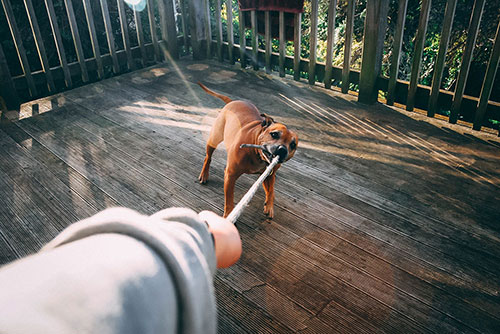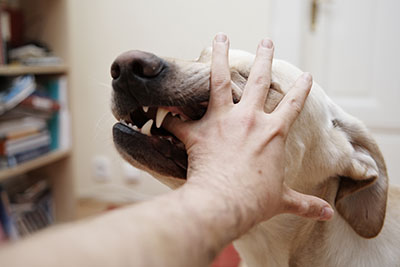Dog Bite
Dog bites cause contaminated puncture wounds, contaminated crush injuries, or both. All carry a high risk of bacterial infection, some also a risk of viral or other infections (e.g., rabies).
Bacterial infection is particularly likely in:

- Puncture wounds (cat/human bites)
- Hand wounds, wounds > 24 hours old
- Wounds in alcoholics, diabetics, or the immunocompromised
Bacteria responsible include: Streptococci, Staphylococcus aureus, Clostridium tetani, Pasteurella multocida (cat bites/scratches), Bacteroides and Eikenella corrodens (human bites).
Categories of Bite Wounds:
Bite wounds fall into 3 categories as listed below:
Category 1: No impact on skin and the skin remains unbroken. For example, petting an animal or providing it with food. Licks also fall under this category.
Category 2: Small scrapes but absence of bleeding.
Category 3: One or many bites which puncture the skin with the animal’s saliva entering the wound.

Management of Bite Wounds:
Cleaning:
Washing using tap water. In the emergency room, we explore fresh bite wounds under appropriate anaesthesia, and debride and clean thoroughly with ‘normal saline’. We also refer significant facial wounds and wounds involving tendons or joints to a specialist.
Closure:
Cosmetic considerations usually outweigh the risks of infection for most facial wounds, so we aim for primary closure. If the wound is large enough, we do delayed primary closure, due to increased risk of infection. We do not close the wound if it is not satisfactorily irrigated.
Antibiotic Prophylaxis:
We generally prescribe antibiotics for:
Puncture bites
- Crush injuries with devitalized tissues
- Bites to the hand, wrist, or genitals
- Bites that are primarily closed
- Bites from humans, cats, dogs and rats
- Bitten patients with immunocompromised state (immunosuppressed, diabetes, post-splenectomy, rheumatoid arthritis) or prosthetic joints
Antibiotic Selection:
Amoxicillin clavulanate is an appropriate broad-spectrum agent, effective against Streptococci, Staphylococci, Pasteurella and Eikenella. Alternatives for adult patients allergic to penicillin/amoxicillin include doxycycline + metronidazole or (especially if pregnant) ceftriaxone alone. In children, azithromycin + metronidazole may be an option. Septicemia is uncommon after bite injury but has been reported with the Gram –ve bacillus Capnocytophaga canimorsus, previously known as Dysgonic fermenter 2 (DF-2).
Tetanus:
Bite wounds are tetanus prone. Hence, tetanus prophylaxis will be given. If it is a large bite wound, we will also prefer tetanus immunoglobulin.
Rabies:
Rabies results after the bullet-shaped RNA rhabdovirus present in the saliva of infected animals is transmitted to humans via a mucous membrane or skin break. The long incubation period of the rabies virus (14– 90 days) allows successful post-exposure prophylaxis at even a relatively late stage, according to present guidelines.
Post exposure prophylaxis (PEP) recommendations on category of exposure:
-
Category I exposureCategory II exposureCategory III exposure
-
Immunologically naive individuals of all age groupsWash exposed skin surfaces. No PEP required.Wound washing and immediate vaccination:
⦁ 2 – sites IM on days 0,3 and 7th day
⦁ (OR)
⦁ 1 – site IM on days 0, 3, 7 and between day 14 – 28
⦁ (OR)
⦁ 2 – sites IM on days 0 and 1 – site IM on days 7, 218
⦁ Rabies Immunoglobulin is not indicated.Wound washing and immediate vaccination
2-sites ID on days 0, 3 and 76
(OR)
1-site IM on days 0, 3, 7 and between day 14-287
(OR)
2-sites IM on days 0 and 1- site IM on days 7, 21
Rabies Immunoglobulin administration is recommended. -
Previously immunized individuals of all age groupsWash exposed skin surfaces.
No PEP required.Wound washing and immediate vaccination:
⦁ 1 – site ID on days 0 and 3
⦁ (OR)
⦁ At 4 – sites ID on day 0
⦁ (OR)
⦁ At 1 – site IM on days 0 and 3
⦁ Rabies Immunoglobulin is not indicatedWound washing and immediate vaccination:
⦁ 1 – site ID on days 0 and 3
⦁ (OR)
⦁ at 4 – sites ID on day 0
⦁ (OR)
⦁ at 1 – site IM on days 0 and 3
Rabies Immunoglobulin administration is not recommended
Rabies Immunoglobulin (RIG):
RIG provides passive immunisation and is administered only once, as soon as possible after the initiation of PEP and not beyond day 7 after the first dose of vaccine. Correctly administered, RIG neutralises the virus at the wound site within a few hours.
To confer the maximum public health benefit, WHO recommends the following:
– The maximum dose is 20 IU (HRIG) and 40 IU (ERIG) per kg body weight. There is no minimum dose.
– Infiltrate as much as possible into the wound; the remainder of the calculated dose of RIG does not need to be injected IM at a distance from the wound but can be fractionated in smaller, individual syringes to be used for other patients, aseptic retention given.
If RIG is not available, thorough, prompt wound washing, together with immediate administration of the first vaccine dose, followed by a complete course of rabies vaccine, is highly effective in preventing rabies. Vaccines should never be withheld, regardless of the availability of RIG.
Pre-Exposure Prophylaxis (PrEP):

Pre-exposure prophylaxis (PrEP) is the administration of several doses of rabies vaccine before exposure to rabies. PrEP is recommended for individuals at higher risk due to occupation. PrEP should be considered in sub-populations living in remote, rabies endemic areas, where access to PEP is difficult and the dog bite incidence is >5% per year.
The immune response to subsequent rabies vaccine boosters such as PEP when exposed, can be recalled very effectively even decades after PrEP.
For immunologically naive individuals of all age groups, WHO recommends the following PrEP schedules: 1-site IM vaccine administration on days 0 and 7.
A routine PrEP booster or serology for neutralising antibody titres is recommended only if a continued, high risk of rabies exposure remains.
Individuals with documented immunodeficiency should be evaluated on a case-by-case basis and best receive an IM PrEP schedule as above, plus a third vaccine administration between days 21 to 28. Additionally, in the event of an exposure, a complete PEP course, including RIG, is recommended.
Prevention of Dog Bites:
Injury prevention measures aimed at preventing children from being bitten include legislation relating to ‘dangerous dogs’ and education. Children may be taught the following:
- To treat dogs with respect.
- To avoid disturbing a dog that is sleeping, eating, or feeding puppies.
- To avoid shouting or running in the presence of a dog.
- Not to approach or play with unfamiliar dogs
For any emergencies or assistance, please reach us at 044 – 4000 6000.

Dr. Karunakaran Vetri
Emergency Physician
Kauvery Hospital, Chennai

